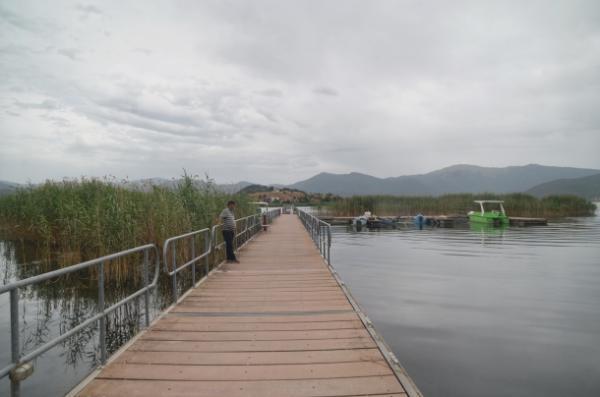The Prespa Lakes, located in Greece’s northwestern corner near the borders of Albania and North Macedonia, present a captivating blend of natural beauty and biodiversity. This region, comprising Great Prespa and Small Prespa, is notable for its pristine waters and rich wildlife, making it a significant destination for ecological tourism. The area is particularly renowned for its bird-watching opportunities, with numerous species inhabiting the lakes and surrounding wetlands. Additionally, the landscape offers a serene escape, characterized by picturesque villages and a tranquil environment. The Prespa Lakes region stands out as a remarkable area for those interested in nature, conservation, and the unique ecological aspects of Greece.

While visiting my nephew in the nearby city of Kastoria, the Prespa Lakes seemed like the perfect day trip destination. We set off on a cloudy morning and arrived after an hour’s drive through the region’s desolate, mountainous landscape.
Agios Achilleios Island in Small Prespa Lake
Our first stop was the island of Agios Achilleios, located on the northern shore of Small Prespa Lake at an altitude of 900 meters. This island hosts a tiny village of about two dozen people, making it one of only two settlements on lake islands in Greece. According to local legend, the village has always had 11 houses, as the 12th house mysteriously collapses every time it is built.
Despite its negligible size and isolated location, Agios Achilleios boasts a prominent history. The island has been inhabited for over a millennium, and during a brief period in the 10th century AD, it became the seat of Tsar Samuel of the First Bulgarian Empire. He arranged for the relics of Saint Achilleios, a 4th-century bishop from Larissa, to be brought there. The island has been named after this saint ever since. The relics of both the saint and the tsar are still buried under the ruins of a basilica, which is the island’s most notable structure.

After several centuries of Ottoman rule, Agios Achilleios became a part of modern Greece in the wake of the Balkan Wars of 1912–13. Its few inhabitants used to commute with the mainland via boat or a precarious walk over the frozen lake in the winter. Ultimately, a floating pedestrian bridge was constructed in 2000. Besides making the locals’ lives easier and safer, this bridge aimed to develop the island’s tourism.

The small parking lot before the bridge was empty except for an elderly couple selling local food products from the back of a pickup truck. Another man loitered at the start of the bridge and warned us of a wasp nest in its railing. The 600-meter walk across the lake was a pleasure in itself. Imposing mountains towered behind the shore reeds. Various birds flew over and swam across the serene lake surface. Two Eurasian coots and a great crested grebe approached us expectantly, seemingly used to being fed by humans.

Besides its eleven houses, the quaint village featured a jetty with a few boats, a canteen, a tavern, and a guest house: an adorable place to stay if seclusion and relaxation are sought. Outside of the village, the island holds several old churches and a monastery worth visiting.

We started our walk with the newest little church of Saint Achilleios, standing atop the hillock above the village. We continued past the 15th-century church of Saint George and above the ruins of the famous 10th-century Basilica of Saint Achillius. The latter is surely the island’s most impressive sight.

Near the island’s southern tip, reached after a mile’s hike, we checked out the 16th-century Monastery of the Virgin Mary. The chapel was open and preserved some frescoes. Lastly, we climbed to the island’s highest point at its southernmost tip. A big white cross was erected there, and a spectacular view of desolate mountains surrounded the lake.

With a stop for a drink and an ice cream in the village, we crossed the bridge back and drove toward the Great Prespa Lake.
Psarades Village on Great Prespa Lake
As the sky blackened and the wind began to rage, we arrived in the village of Psarades. This is the only settlement on the Greek side of Great Prespa Lake. It gained attention in 2018 when the Greek and North Macedonian prime ministers met there to sign the Prespa Agreement, which aimed to end the decades-long dispute over the new nation’s name. The village’s name, meaning “fishermen,” reflects its principal economic activity. Besides fishing, its inhabitants raise a rare breed of cattle and dabble in tourism.

Psarades has a few hotels, all in charming stone houses, as well as several taverns and cafes. Locals offer boat rides, and picturesque shoreside trails lead to old churches and rock paintings.

We were planning to explore, but we barely got to walk up and down the village before a fierce storm erupted, sending us running back to the car and on our way to Kastoria.
Accommodation and Activities in Greece
Stay22 is a handy tool that lets you search for and compare stays and experiences across multiple platforms on the same neat, interactive map. Hover over the listings to see the details. Click on the top-right settings icon to adjust your preferences; switch between hotels, experiences, or restaurants; and activate clever map overlays displaying information like transit lines or concentrations of sights. Click on the Show List button for the listings to appear in a list format. Booking via this map, I will be earning a small cut of the platform's profit without you being charged any extra penny. You will be thus greatly helping me to maintain and keep enriching this website. Thanks!
